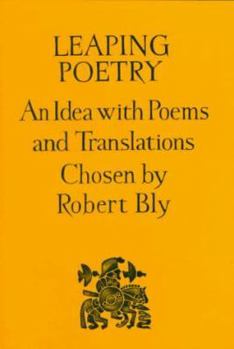Leaping Poetry Pa
Select Format
Select Condition 
Book Overview
Leaping Poetry is Robert Bly's testament to the singular importance of the artistic leap that bridges the gap between conscious and unconscious thought in any great work of art; the process that Bly... This description may be from another edition of this product.
Format:Paperback
Language:English
ISBN:0807063932
ISBN13:9780807063934
Release Date:January 1975
Publisher:Beacon Press (MA)
Length:93 Pages
Weight:0.32 lbs.
Dimensions:0.3" x 5.4" x 8.0"
Customer Reviews
3 ratings
Bly Leaping Rhetorically
Published by Thriftbooks.com User , 15 years ago
In brief Bly states that "a poet who is leaping makes a jump from an object soaked in unconscious substance to an object or idea soaked in conscious psychic substance." He argues that ancient poets leaped naturally; however, over the centuries formulas and rules killed the "leap." Now, however, certain poets are reviving the "leap." Through the presentation of his thesis, Bly uses several rhetorical devices to define his concept. He compares and contrasts. For instance, he points out the difference of the Spanish poets and the French surrealists and finds the Spanish writers more satisfying. He provides examples of Leaping poets: he discusses Blake, Wallace Stevens, Neruda, Vallejo, and Rilke. He illustrates "leaping" through poems that he has translated and he explicates the jumps. In summary, Robert Bly's "Leaping Poetry" is important for several reasons: (1) he creates an evocative and simple image (leaping) for a concept that poets of a certain ilk have been trying to explain for centuries; (2) he examines and meditates on the concept with plenty of examples from poets like Lorca, Neruda, Rilke, Vallejo; (3) he shows the similarities of leaping poetry to Lorca's concept of duende; (4) he finds a physiological source of leaping by discussing the work of Paul Maclean; and (5) he presents us with some fine translations of poets from around the world.
Deep Image.
Published by Thriftbooks.com User , 17 years ago
I'm taking a class on Deep Image poetry, and let me tell you, I had a hard time differentiating between deep image and surrealism. I consider myself to be a surrealist so it was hard to bridge the small gap, but Bly did a wonderful job of walking me through what deep image is in this work of art.
Learn the definition of "Dragonsmoke".
Published by Thriftbooks.com User , 25 years ago
'In ancient times, in the "time of inspiration", the poet flew from one world to another, "riding on dragons".... They dragged behind them long tails of dragonsmoke.... This dragonsmoke means that a leap has taken place in the poem. In many ancient works of art we notice a long floating leap at the center of a work. That leap can be described as a leap from the conscious to the unconscious and back again, a leap from the known part of the mind to the unknown part and back to the known.'So begins one of the most fascinating books I have read in the past several years. Robert Bly gives us his wonderful idea about "leaping", surreal poetry and pays homage to the modern masters of this method, largely Spanish poets such as Neruda, Lorca and Vallejo. Involved in this idea are the concepts of Wild Association and the presence of three brains involved in a complex relationship within the human mind.After this book, you will never look at art, any art, the same way again.





